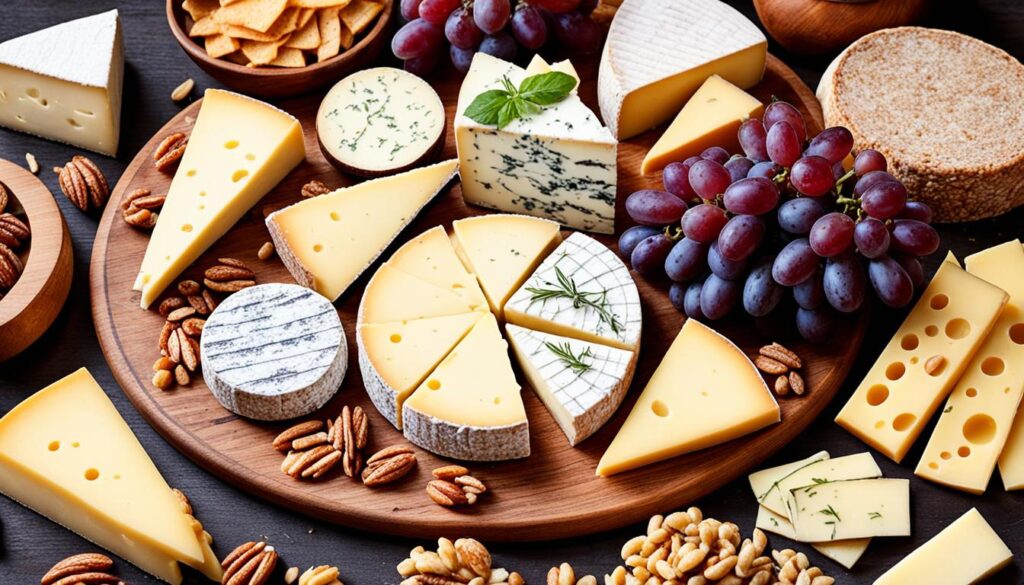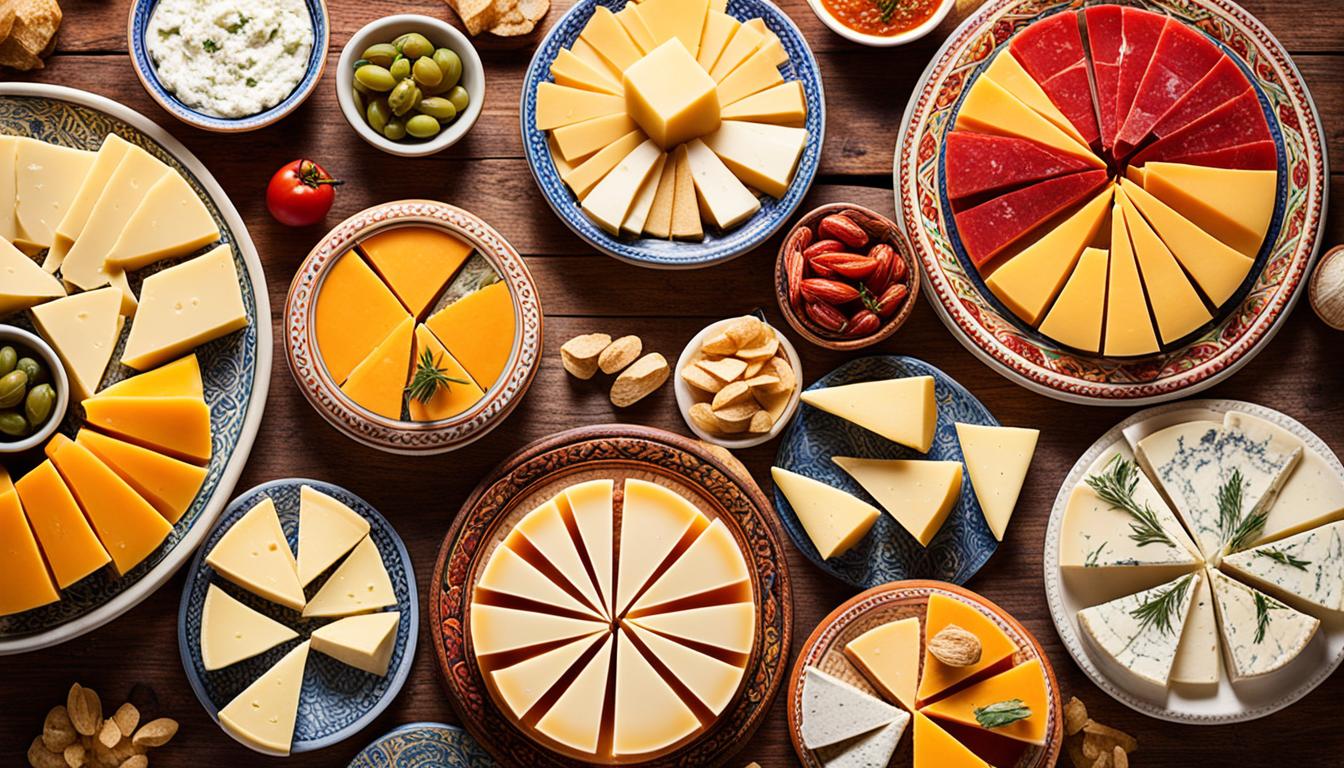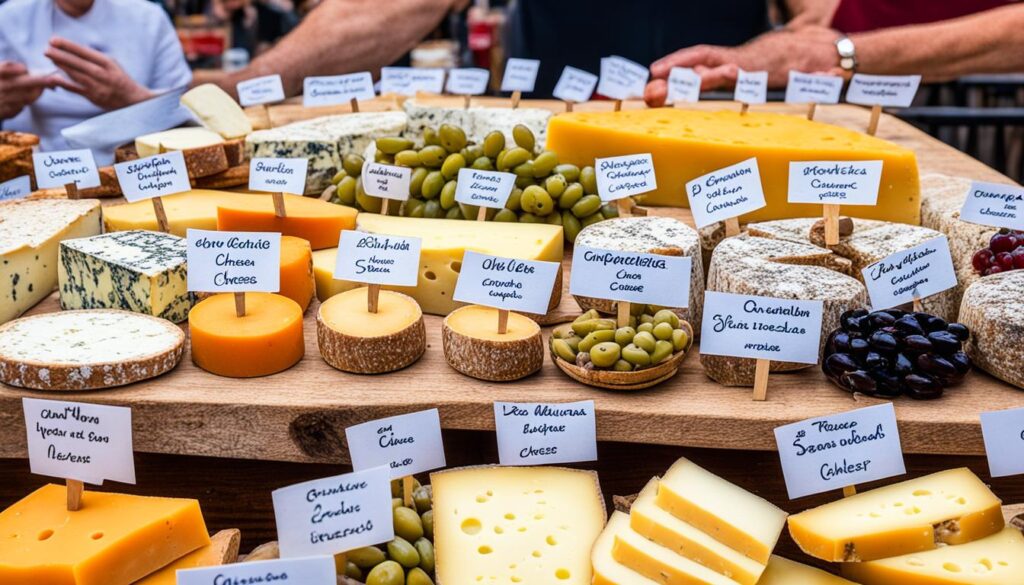Spain is famous for its wide range of artisanal cheeses, with more than1 150 types across the country.1 Every region has its own special cheese, from fresh to blue-veined varieties. The key to these cheeses is the milk type, the climate, and a long tradition of cheese-making.2
Cheese is a big part of Spanish food, enjoyed on its own, in tapas, or as a sweet treat. The different climates and lands in Spain let each area make high-quality cheeses. These cheeses have unique features like the milk source, how they’re made, and their aging process.2
Spain now has1 26 cheeses protected by the European Union’s Denominations of Origin (DOP). This means they come from certain areas and are made in a traditional way. These DOP cheeses have a long history, with each region having its own special methods and traditions.1
Key Takeaways
- Spain produces over 150 different varieties of artisanal cheese, each with its own unique characteristics.
- Spanish cheese-making has a long and storied history, with 26 Denominations of Origin (DOP) protected by the European Union.
- Cheese is a beloved and integral part of Spanish cuisine, enjoyed in a variety of ways, from stand-alone dishes to tapas and desserts.
- Each region of Spain offers its own specialty cheeses, made with different types of milk and using traditional production methods.
- The diversity of Spanish cheeses reflects the country’s rich culinary heritage and commitment to quality and authenticity.
Exploring the Rich Tradition of Spanish Cheese Making
Spain is a paradise for cheese lovers, with a wide variety of unique and high-quality cheeses. These cheeses are deeply rooted in Spain’s rich cultural heritage. From the famous Manchego to the bold Cabrales blue cheese, Spanish cheesemakers have perfected their craft over centuries. They create a diverse array of cheeses that reflect the unique terroir and traditions of each region.3
Spain’s Diverse Cheese Varieties
Spanish cheeses show the country’s varied geography and rich cheese-making traditions. In the north, along the Cantabrian coast and the Pyrenees, you’ll find many cow’s milk cheeses. Inland, sheep’s milk cheeses are popular from Cantabria and the Basque Country down to the central plains. The Mediterranean coast offers a variety of goat’s milk cheeses, while the Canary and Balearic Islands have a mix of goat, sheep, and cow’s milk cheeses.3
Regional Specialties and Terroir
Every Spanish region has its own cheese-making history, process, and environmental conditions. These factors give rise to distinct and differentiated cheeses. The terroir, or the unique combination of soil, climate, and local traditions, is key to shaping the flavor profiles and characteristics of these cheeses.3
Traditional Cheese-Making Techniques
Spanish cheesemakers have preserved time-honored techniques and recipes for generations. They produce artisanal cheeses like Cabrales blue cheese in the Picos de Europa mountains. Each step of the cheese-making process is filled with tradition and attention to detail, from hand-rubbing Mahón-Menorca cheese with olive oil and paprika.4
| Cheese Variety | Region | Milk Type | Notable Characteristics |
|---|---|---|---|
| Cabrales | Asturias | Cow, Goat, Sheep | A symphony of bold, pungent flavors from the mix of milk types.4 |
| Manchego | La Mancha | Sheep | A rich, nutty sheep’s milk cheese, aged for varying periods to develop distinct flavors and textures.5 |
| Mahón-Menorca | Menorca | Cow | A cow’s milk cheese with a hand-rubbed rind of olive oil and paprika.4 |
| Burgos | Castile and León | Sheep, Cow, Goat | A blend of sheep, cow, and goat’s milk, resulting in a creamy and flavorful cheese.4 |
| Torta del Casar | Extremadura | Sheep | A sheep’s milk cheese coagulated using natural thistle, resulting in a unique and complex flavor.4 |
| Tetilla | Galicia | Cow | A mild and creamy cow’s milk cheese with a distinctive cone shape.5 |
| Idiazabal | Basque Country | Sheep | A rustic, farmhouse cheese made from sheep’s milk, often with a subtle smoky flavor.5 |
Spain’s cheese-making tradition showcases the country’s diverse geography, climate, and cultural heritage. From the terroir-driven regional specialties to the time-honored techniques passed down through generations, Spanish cheesemakers have created a culinary legacy. This legacy continues to captivate cheese lovers around the world.3
Unveiling the most popular cheese in Spain: Manchego
Among Spain’s diverse cheeses, Manchego shines as a star. Its rich history, unique making, and distinct taste have won hearts worldwide. It’s a favorite among cheese lovers.
Origins and History of Manchego
Manchego cheese’s roots go back to the Roman times in La Mancha’s sheep-raising tradition. 1 This tradition has been kept alive, making Manchego a Spanish cuisine staple. It now has a Denomination of Origin (DOP), ensuring its quality and origin.
Production Process and DOP Certification
Creating Manchego cheese is detailed and traditional. It ages for at least 60 days, sometimes up to two years, for a richer taste. 1 It’s made from Manchego sheep’s raw milk, using age-old techniques. 1 The DOP status confirms it’s made in a specific area, following strict quality and traditional methods.
Flavor Profile and Versatility
Manchego’s flavor varies from sweet and nutty to sharp and tangy, based on its age. 2 It’s great on its own or with cured meats and olives. It’s also used in many Spanish dishes, like tapas and stews. Its unique taste and texture are loved by cheese enthusiasts worldwide.
Manchego’s lasting fame shows Spain’s rich food culture and its cheesemakers’ commitment to tradition and quality. It’s a must-try for anyone exploring Spanish cheeses, offering a true taste of Spain’s culinary wonders.
Other Famous Spanish Cheese Varieties
Spain is known for more than just Manchego cheese. It has a wide range of famous cheeses, each with its own story and taste. Cabrales blue cheese and Mahón from the Balearic Islands are two examples that are loved by cheese lovers all over the world.
Cabrales: The Bold and Pungent Blue Cheese
Cabrales is a unique blue cheese made by hand in the Picos de Europa mountains of Northern Spain.8 It’s aged in caves with special winds, giving it a strong taste. This cheese is made from cow, sheep, and goat milk, with cow’s milk adding a special touch.8 It’s considered one of Spain’s best blue cheeses, with a variety of flavors.
Mahón: The Fruity Cheese from the Balearic Islands
Mahón cheese comes from Menorca’s capital city.9 For centuries, local farmers have made this cheese. Experts then age it in underground cellars for one to two years.8 They use butter, paprika, and olive oil on the rind, giving it a unique taste.
These cheeses, along with many others in Spain, show the country’s rich cheese-making tradition. From the strong Cabrales to the sweet Mahón, Spanish cheeses offer a wide range of tastes for everyone to enjoy.
Exploring Spanish DOP Cheese Regions
Spain is famous for its cheese, with 26 Denominations of Origin (DOP) recognized by the European Union.11 Each DOP has its own special features, like the milk type, aging, and cheese shape. These traditions go way back, with each area perfecting its own methods over time.
La Mancha: Home of Manchego
Manchego cheese comes from La Mancha and is made from sheep’s milk. Its history goes all the way back to the Romans.12 Now, it’s a DOP-protected cheese, made in a specific area using old techniques. This gives it a firm texture, a yellow rind, and a nutty taste that’s loved in Spanish food.
Asturias: Renowned for Cabrales
In Asturias, the strong and smelly Cabrales blue cheese is a hit. It’s made by hand on small farms in the Picos de Europa mountains. The cool caves where it ages give it a blue color and a strong, rich taste.11
Menorca: Birthplace of Mahón Cheese
Menorca is where the tasty Mahón cheese comes from. Local farmers make this semi-hard cheese, aging it in cellars for up to two years. The rind gets rubbed with butter, paprika, and olive oil, making it even more delicious.12
These are just a few of Spain’s amazing DOP cheeses. Each DOP area has its own story and way of making cheese. Exploring Spain’s DOP cheese regions is a great way to learn about its food culture.
Serving and Pairing Spanish Cheeses
Exploring Spanish cheeses is more than just tasting them. These cheeses pair well with many foods, enhancing the flavor. Manchego, Cabrales, and Mahón each have unique tastes that match perfectly with certain foods.
Wine and Cheese Pairings
Spanish cheeses and wine are a great match. Manchego goes well with a strong red wine like Tempranillo or Rioja. Cabrales blue cheese pairs with sweet dessert wine or acidic white wine. Mahón’s salty-buttery flavor is good with a crisp, dry white wine.13
Spanish Cheese Plates and Tapas
Spanish cheeses are also great on cheese plates or in tapas. A cheese plate might include Manchego, Cabrales, and Mahón. It can also have cured meats, olives, nuts, and bread.14 In tapas, you can enjoy Manchego with honey, Cabrales on toast, or Mahón with olive oil, tarragon, and black pepper.

Pairing Spanish cheeses with the right flavors is a fun way to enjoy these artisanal products. Whether on their own or in Spanish dishes, these cheeses add a delicious touch to any meal.
The Cultural Significance of Cheese in Spain
Cheese is a big part of Spanish culture and food. It’s loved on its own and in tapas and desserts. The production of Denominación de Origen Protegida (DOP) cheeses in Spain has a long history. Each region has its own way of making cheese, passed down through the ages.15
Cheese in Spanish Cuisine
Cheese plays a key role in Spanish food, showing off the country’s rich food history. From Manchego to Cabrales blue and Idiazabal, Spanish cheeses are key in many dishes and tapas.16 These cheeses are not just food but also a source of pride for the regions that make them.
Artisanal Cheese Production
Spain’s artisanal cheese-making is a big part of its food culture. Small producers keep old techniques alive, making over 100 types of cheese. Many cheeses have DOP status, which protects their making in certain areas and quality standards.15 This effort keeps Spanish cheeses unique and loved worldwide.
Cheese in Spain shows the country’s love for its food traditions and the talent of its makers. From famous Manchego to unique regional cheeses, they are a big part of Spain’s food heritage. They connect people to the land and its history.
Exploring Lesser-Known Spanish Cheese Gems
Spain is more than just Manchego and Cabrales. It has many regional cheeses worth trying. From Roncal’s nutty taste to Idiazábal’s smoky flavor and Majorero’s unique touch, these cheeses show Spain’s rich food culture.
Roncal: A Nutty Sheep’s Milk Cheese
Roncal cheese comes from the Roncal Valley in the Pyrenees Mountains.17 It’s made from the milk of special sheep that live in the high mountains or Bardena area of Navarra.17 This cheese has a nutty, slightly sweet taste and a firm texture that reflects the region’s beauty.
Idiazábal: The Smoky Basque Cheese
Idiazábal is a traditional cheese from the Basque Country.17 It’s made from sheep’s milk and aged for at least two months, giving it a smoky flavor.17 This unique smoking process makes Idiazábal different from other Spanish cheeses.17
Majorero: The Unique Goat’s Milk Cheese from Fuerteventura
Majorero is a beloved cheese from Fuerteventura, Canary Islands.18 It’s made with the milk of local goats and up to 15% sheep’s milk.18 This creates a cheese that’s fatty and full of flavor, showing off the island’s unique character.
Exploring these lesser-known cheeses takes you on a journey through Spain’s cheese-making history. They offer a variety of tastes, from nutty to smoky to pungent. These cheeses are a must-try for anyone looking to discover Spain’s culinary wonders.
| Cheese | Region | Milk Type | Flavor Profile |
|---|---|---|---|
| Roncal | Roncal Valley, Pyrenees | Sheep | Nutty, slightly sweet |
| Idiazábal | Basque Country | Sheep | Smoky |
| Majorero | Fuerteventura, Canary Islands | Goat, with sheep’s milk | Fatty, pungent |
Conclusion
Spain is known for its unique and high-quality cheeses, many with Denominations of Origin (DOPs). These protect how they’re made and where they come from.19 Cheeses like Manchego, bold Cabrales blue, and smoky Idiazabal show the skill of Spanish cheesemakers.20
While Spanish cheeses like these are famous, there are many hidden gems to find. Each has a special taste and a story of the land.21 Cheese plays a big role in Spanish food and culture, enjoyed on its own or in dishes and tapas. Exploring Spanish cheeses is like a tasty adventure into the country’s food heritage.
FAQ
What are the essential characteristics of Spanish cheese?
How many Denominations of Origin (DOP) for cheese does Spain have?
What is the history of Manchego cheese?
What are the unique characteristics of Cabrales blue cheese?
What makes Mahón cheese distinctive?
What are some lesser-known regional Spanish cheese specialties?
Source Links
- https://spainguides.com/gastronomy-of-spain/spanish-cheese/
- https://www.chefspencil.com/top-20-most-popular-cheeses-in-spain/
- https://www.ibericoclub.com/exploring-the-rich-flavors-of-mahon-cheese/
- https://recipes.net/articles/types-of-cheese-in-spain/
- https://www.ibericafood.com/Recipes/post/exploring-the-rich-flavours-of-artisan-spanish-cheeses-a-journey-to-discover-the-true-flavours-of-spain
- https://www.cheeseprofessor.com/blog/dop-manchego-1605
- https://winetourismspain.com/blog/unique-spanish-cheeses/
- https://www.palacios.us/for-you/gastronomy-tips/the-most-popular-spanish-cheeses
- https://thespanishradish.com/spanish-radish-blog/types-of-spanish-cheese/
- https://www.france44cheeseshop.com/blog/2022/6/8/cheese-profile-spanish-cheeses
- https://www.cheeseprofessor.com/blog/9-great-spanish-cheeses
- https://igourmet.com/blogs/gourmet-food-guide/spanish-cheese-cheese-guide
- https://legourmetcentral.com/our-blog/8-spanish-cheeses-you-need-to-try/
- https://www.totallyspaintravel.com/2016/08/10/totally-spains-guide-cheese-in-spain/
- https://www.ilovecheese.co.uk/cheeses-of-the-world/spanish-cheese-and-cheese-making-culture/
- https://iloveimportedcheese.com/all-about-the-heritage-of-cheeses-from-spain/
- https://www.idealista.com/en/news/lifestyle-in-spain/2022/08/19/7974-5-spanish-cheeses-you-have-to-try
- https://www.euronews.com/travel/2020/09/24/the-delicious-hidden-gems-of-spain-s-cheese-revolution
- https://socarratnyc.com/blog/food-culture/spanish-cheese-varieties/
- https://thecheesewanker.com/trivia/manchego/
- https://recipes.net/articles/manchego-cheese/


Leave a Reply
You must be logged in to post a comment.